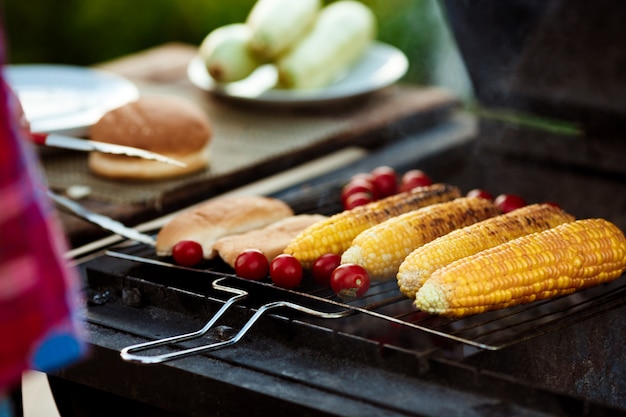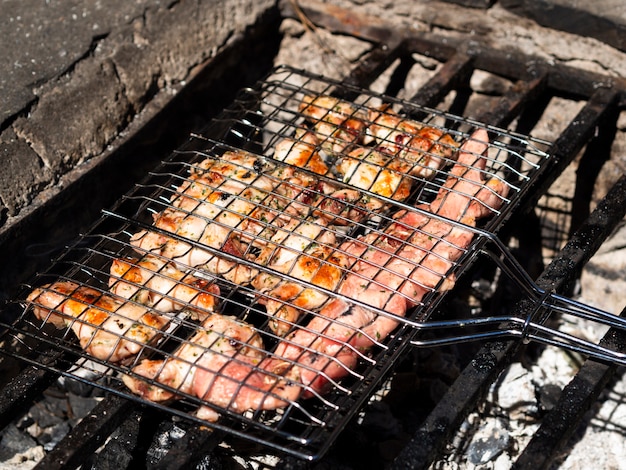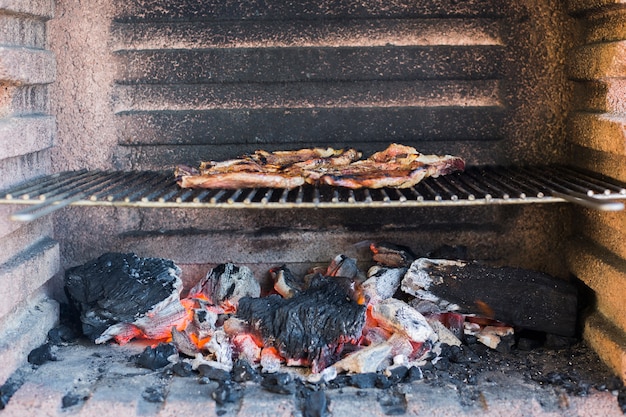How do you indirect cook on a BBQ?
Indirect cooking on a BBQ is a popular technique that allows for slow and even cooking of food. It involves setting up your grill in a way that the heat source is not directly under the food being cooked. This method is especially useful for larger cuts of meat, delicate foods, and dishes that require longer cooking times.
The Benefits of Indirect Cooking
Indirect cooking offers several benefits over direct grilling. First and foremost, it allows for better control of the cooking temperature. By placing the food away from the direct heat source, you can avoid flare-ups and prevent burning or charring. This technique is ideal for achieving succulent and tender results, as it allows the meat to cook slowly and retain its natural juices.
Another advantage of indirect cooking is the ability to add smoke flavor to your food. By using wood chips or chunks, you can infuse your dishes with a delicious smoky aroma that enhances the overall taste.
Setting Up Your BBQ for Indirect Cooking
To get started with indirect cooking, follow these steps:
- Prepare your charcoal or gas grill by cleaning the grates and removing any debris.
- If using a charcoal grill, light the briquettes and let them burn until they are covered with white ash. For a gas grill, preheat the burners on one side of the grill.
- For charcoal grills, create a two-zone setup by placing the lit coals on one side of the grill and leaving the other side empty. This creates a hot zone and a cooler zone for indirect cooking. If using a gas grill, simply turn off the burners on one side.
- Place a drip pan filled with water or other liquid on the cooler side of the grill. This helps to maintain moisture and prevent flare-ups.
Indirect Cooking Techniques
There are several techniques you can utilize when indirect cooking on a BBQ:
Smoking
Smoking involves adding wood chips or chunks to your grill to produce smoke, which imparts a unique flavor to your food. Soak the wood chips in water for about 30 minutes before placing them on the hot coals or in a smoker box for gas grills. Add the food to be smoked on the cooler side of the grill and close the lid to allow the smoke to infuse into the meat or vegetables.
Roasting
Roasting is perfect for larger cuts of meat such as whole chickens, roasts, or turkeys. Place the meat on the cooler side of the grill, close the lid, and let it cook slowly until it reaches the desired temperature. Use a meat thermometer to ensure proper doneness.
Indirect Grilling
Indirect grilling is a combination of direct and indirect cooking. Start the food on the hot side of the grill to sear and create grill marks, then move it to the cooler side to finish cooking through without burning.
Indirect cooking on a BBQ opens up a whole new world of culinary possibilities. From tender ribs to perfectly smoked brisket, this technique allows you to achieve professional-level results in the comfort of your own backyard.
What is the difference between direct and indirect grilling?
Grilling is a popular cooking method in the UK, especially during the summer months. Whether you are a seasoned grilling enthusiast or just starting out, it’s essential to understand the difference between direct and indirect grilling techniques to achieve the best results with your barbecued dishes.
Direct Grilling
Direct grilling involves cooking food directly over the heat source. This method is ideal for quickly searing steaks, burgers, or vegetables, giving a crispy exterior while maintaining a juicy interior. The intense heat allows for shorter cooking times and creates distinct grill marks on the food.
“Direct grilling is like cooking on an open flame; it provides that smoky flavor and charred texture that many people love in their grilled food.”
To direct grill, place the food directly over the heat source, typically at a high temperature (around 400°F or higher). Make sure to flip the food halfway through to ensure even cooking.
Indirect Grilling
Indirect grilling involves cooking food away from the heat source, using a two-zone fire setup. This method is suitable for larger cuts of meat, such as roasts or whole chickens, which require longer cooking times and lower temperatures. The indirect heat gently cooks the food without burning the exterior.
“Indirect grilling allows for slow, even cooking, resulting in tender and moist meat.”
To indirect grill, light only one side of the grill, leaving the other side unlit. Place the food on the unlit side and close the lid to create an oven-like environment. This technique is great for smoking, as wood chips can be added to the grill for additional flavor.
Here’s a summary of the main differences between direct and indirect grilling:
| Direct Grilling | Indirect Grilling |
| Cooking directly over the heat source | Cooking away from the heat source |
| High temperatures (400°F+) | Lower temperatures for slow cooking |
| Short cooking times | Longer cooking times |
| Ideal for smaller cuts of meat and quick searing | Suitable for larger cuts of meat and smoking |
By understanding the differences between direct and indirect grilling, you can choose the appropriate method for your desired dish and achieve delicious results every time. So fire up your grill and experiment with both techniques to add that wonderful smoky flavor to your favorite foods!
What are the Benefits of Indirect Grilling?
Indirect grilling is a cooking technique that involves positioning food away from direct heat, allowing it to cook slowly and evenly. This method offers several benefits for your culinary creations, making it a popular choice among grill enthusiasts in the UK.
Even Cooking
One of the main advantages of indirect grilling is that it promotes even cooking. By placing the food away from the flames or heat source, you can prevent the outside of your dish from burning while ensuring the inside is cooked to perfection.
Tender and Juicy Results
Indirect grilling helps retain the natural moisture and juices in your food. The slower cooking process allows the meat to become tender and juicy, creating a mouthwatering dining experience for you and your guests. Whether you’re grilling a succulent steak or a rack of ribs, indirect grilling will help you achieve incredible flavor and texture.
Enhanced Flavor
With indirect grilling, you have the opportunity to infuse your food with delicious smoky flavors. By using wood chips, such as hickory or mesquite, you can add a rich and aromatic taste to your grilled dishes. The low and slow cooking method also allows for better absorption of marinades and rubs, further enhancing the overall flavor profile.
Versatility
Indirect grilling offers great versatility in terms of the types of food you can cook. This method is ideal for larger cuts of meat, roasts, whole poultry, and even delicate fish fillets. You can also incorporate vegetables and fruits into your indirect grilling recipes, creating a variety of delicious and healthy options for your meals.
Temperature Control
Another advantage of indirect grilling is the ability to have better control over the cooking temperature. By positioning the food away from direct heat, you can adjust the temperature inside the grill more easily. This makes it simpler to achieve specific cooking levels, whether you prefer rare, medium, or well-done meat.
Indirect grilling is a fantastic technique for achieving perfectly cooked meat that is tender, juicy, and full of flavor. It provides a versatile cooking method and allows for greater control over temperatures. Give it a try, and elevate your grilling game to new heights!
Which grilling method is healthiest?
Grilling is a favorite pastime for many Brits during the summer months, but have you ever wondered which grilling method is the healthiest? Whether you’re a fan of gas, charcoal, or electric grilling, each method has its own pros and cons when it comes to health benefits.
Gas Grilling
Gas grilling is a popular choice due to its convenience and ease of use. It heats up quickly and allows for precise temperature control, which can be beneficial when cooking lean meats or vegetables. Additionally, gas grills tend to produce less smoke compared to charcoal grills, reducing the risk of exposure to harmful chemicals.
Charcoal Grilling
Charcoal grilling is often favored for the unique smoky flavor it imparts on food. However, this method has some drawbacks when it comes to health. The charcoal briquettes used in traditional grilling contain additives and binders that may release potentially harmful chemicals when burned. It’s important to use natural lump charcoal or hardwood charcoal to minimize the risks.
Electric Grilling
Electric grilling is a convenient and smoke-free option for those living in apartments or areas with strict fire regulations. This method eliminates the need for open flames and produces less smoke and soot. Electric grills also allow for better temperature control, making it easier to cook food evenly.
When it comes to choosing the healthiest grilling method, here are a few tips:
- Opt for lean cuts of meat to reduce fat intake.
- Marinate your food before grilling to help reduce the formation of harmful compounds.
- Precook meat partially to reduce the grilling time and minimize the formation of carcinogens.
- Keep a safe distance from open flames and avoid excessive charring.
Remember, moderation is key. Enjoy grilling as part of a balanced diet and incorporate plenty of fruits and vegetables into your meal.
Ultimately, the healthiest grilling method depends on your personal preferences and priorities. Choose the method that suits your lifestyle and always prioritize safety and moderation when enjoying grilled foods.
What is the Indirect Grilling Time?
Grilling is a popular cooking method, especially during the summer months when barbecues are in full swing. While direct grilling is commonly known and used, indirect grilling is an equally important technique for achieving perfect results with certain types of food.
Understanding Indirect Grilling
Indirect grilling involves using the heat from the coals or burners on one side of the grill to cook the food on the other side. This method is ideal for larger cuts of meat that require longer cooking times at lower temperatures, as well as delicate foods that can easily burn. By placing the food away from the direct heat source, it cooks more slowly and evenly, resulting in tender and flavorful dishes.
Indirect Grilling Time
The indirect grilling time can vary depending on the type and size of the food being cooked. It is important to have an idea of how long different items may take to cook to ensure they are done to perfection.
To help you get started, here is a general guide to indirect grilling times for some common barbecue favorites:
- Whole Chicken (4-6 lbs): Approximately 1.5 to 2 hours
- Ribs (Baby Back or Spare): About 2 to 3 hours
- Pork Shoulder: Allow 5 to 6 hours for a 5-pound roast
- Salmon Fillets: Cook for around 15 to 20 minutes
These times are approximate and can vary based on factors such as the grill’s temperature, the thickness of the meat, and personal preference for doneness. It is always best to use a meat thermometer to ensure the food reaches the desired internal temperature.
Tip: For even more flavor, consider using wood chips for smoking during the indirect grilling process.
Indirect grilling is a versatile technique that allows you to create mouthwatering barbecue dishes with tender meat and perfectly cooked vegetables. By understanding the concept and having a general idea of cooking times, you can master the art of indirect grilling and impress your guests at your next backyard cookout.



